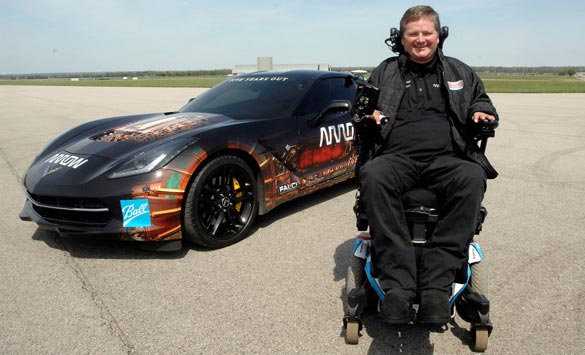Semi-Autonomous Vehicle Gets Disabled Racer Back in Driver’s Seat

The Arrow Semi-Autonomous Motorcar (SAM) 3.0 is a 650-horsepower 2016 Corvette X06. Image Courtesy of Arrow Electronics
Latest News
June 29, 2017
Sam Schmidt, a former driver paralyzed in a 2000 race car accident, recently achieved a long-standing dream to compete against legend Mario Andretti on the Indianapolis Speedway, thanks to a semi-autonomous motorcar (SAM) project spearhead by Arrow Electronics, which let him go head-to-head with the celebrated driver.
The Arrow SAM car, in its third iteration, is based on a 650-horsepower 2016 Corvette Z06 stocked with an array of the latest technological advances to aid in autonomous operation. The first version sported some autonomy for steering, acceleration and braking controls, the second iteration added integrated cameras, networking and programming to improve handling and precision. The current version goes even further, allowing disabled drivers like Schmidt to operate the vehicle using a headset, motion-tracking sensors, and “sip and puff” interaction.
 The Arrow Semi-Autonomous Motorcar (SAM) 3.0 is a 650-horsepower 2016 Corvette X06. Image Courtesy of Arrow Electronics
The Arrow Semi-Autonomous Motorcar (SAM) 3.0 is a 650-horsepower 2016 Corvette X06. Image Courtesy of Arrow ElectronicsThe SAM car team’s mission is to apply technology to aid in innovative, humanitarian ways to improve lives, Arrow officials said. The group started in 2013 as a collaboration between Arrow engineers and medical researchers to figure out how to modify a car so it could be driven safely at speed by a quadriplegic using head movements. Partner Ball Aerospace came up with a system of infrared cameras and sensors that could track head movements of the driver in real time, essentially turning the driver’s head into a joystick, officials explained.
In the subsequent version of SAM, partner Freescale Semiconductor evolved the infrared camera system to be more responsive to nuanced head movements by the driver, while acceleration and braking actions were combined so they could be handled from a single mouth device. The SAM team also had to design a central processor unit capable of translating all of the sensory and camera data into actual car movements—for example, controlling rotary actuators linked to the gas and brake pedals as well as steering wheel.
In the version of SAM used in the recent Schmidt/Andretti faceoff, there is even more technology to aid in autonomous operation. Schmidt wore a headset equipped with motion tracking sensors similar to the motion capture technology used in Hollywood movies along with a sip-and-puff device used to accelerate and brake the car by inhaling in and out.
The Internet of Things (IoT) also plays a big role in the vehicle design, with the Arrow Connect IoT platform enabling live streaming of the telemetry, driver biometrics, and environmental conditions to stay on top of driver operation and to ensure safety. There are also modified off-the-shelf electric motors that ingest data from the sip-and-puff and main computers and use it to control the steering and braking systems, Arrow officials said.
In the big race, held May 13, Schmidt came in a close second to Andretti (who also competed using SAM technology) racing at speeds upwards of 100 mph. Schmidt had good preparation for the race: Last year, he hit 152 mph in the Arrow SAM car during a pre-race demonstration at the Indianapolis 500, and he also raced up Pikes Peak in Colorado, topping 80 mph.
To learn more about how Arrow’s Semi-Autonomous Motorcar works, watch this video.
Subscribe to our FREE magazine, FREE email newsletters or both!
Latest News
About the Author
Beth Stackpole is a contributing editor to Digital Engineering. Send e-mail about this article to [email protected].
Follow DE





